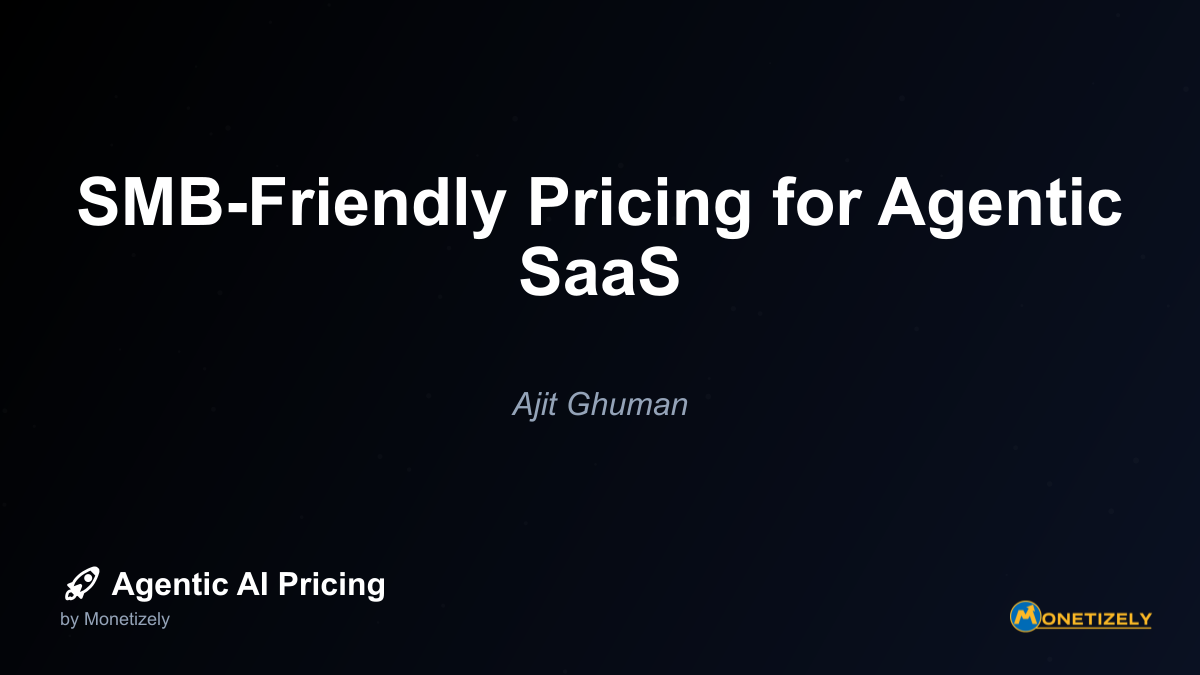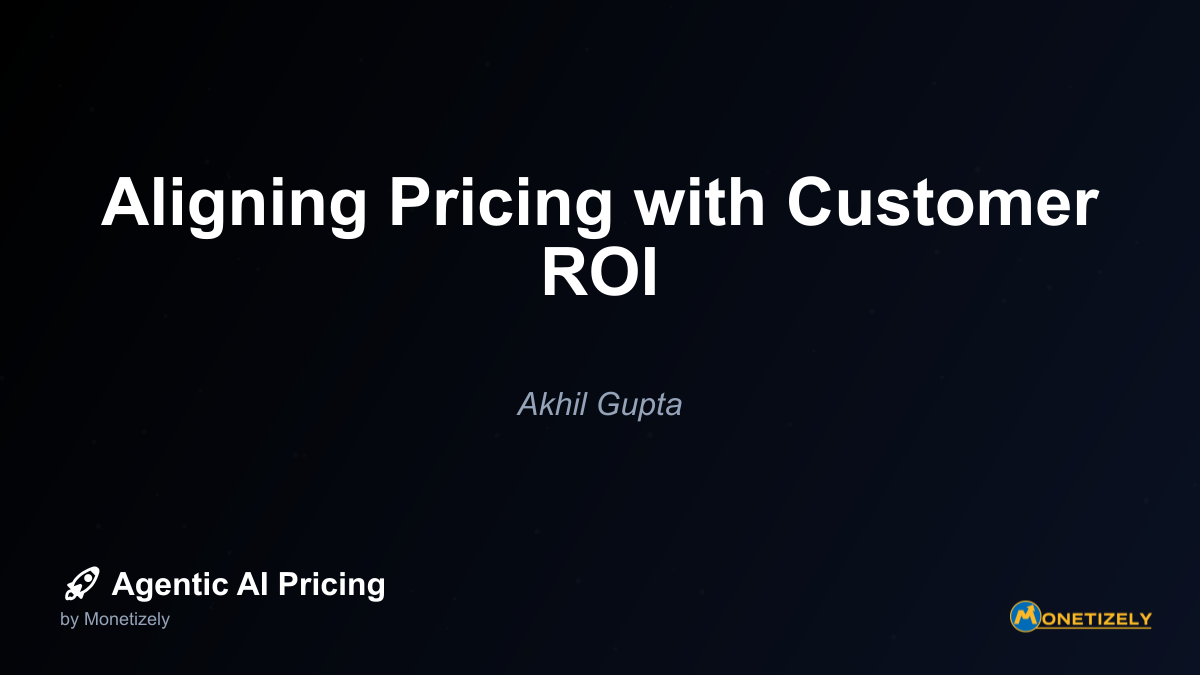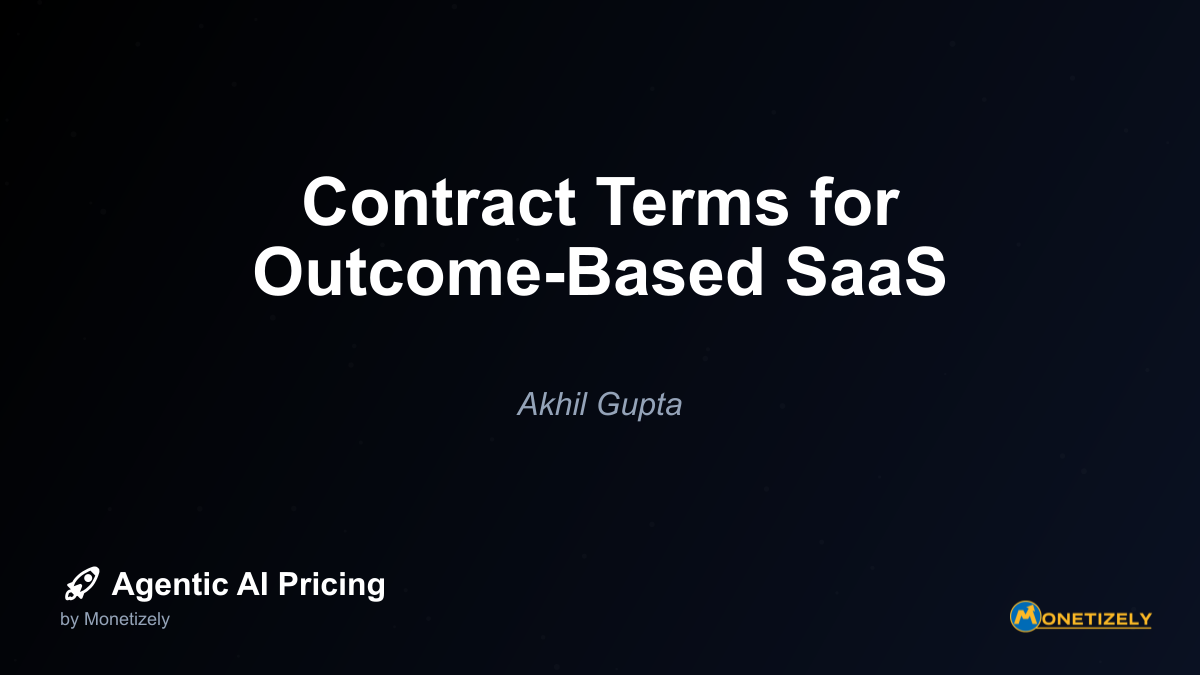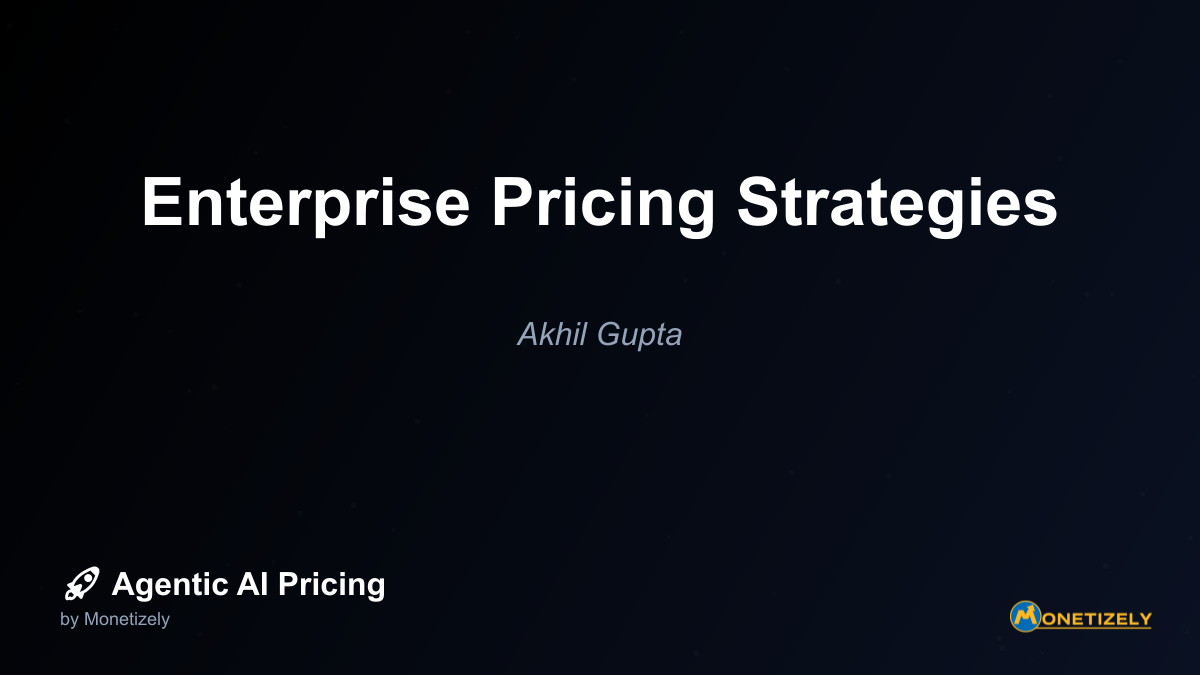· Ajit Ghuman · Pricing Agentic SaaS Products · 8 min read
SMB-Friendly Pricing for Agentic SaaS
AI and SaaS Pricing Masterclass
Learn the art of strategic pricing directly from industry experts. Our comprehensive course provides frameworks and methodologies for optimizing your pricing strategy in the evolving AI landscape. Earn a professional certification that can be imported directly to your LinkedIn profile.

Key Pricing Models for SMB-Friendly Agentic SaaS
Let’s explore the most effective pricing strategies that make agentic AI accessible to small and medium-sized businesses.
Freemium with Clear Upgrade Paths
The freemium model has proven particularly effective for introducing SMBs to agentic AI solutions. By offering a free tier with core functionality, businesses can experience value before committing financial resources.
What makes freemium work for SMBs:
- Risk elimination: SMBs can validate the solution’s value without upfront investment
- Self-education: Free users can learn the platform at their own pace
- Organic growth: Team members can become advocates after experiencing benefits firsthand
- Predictable upgrade triggers: Clear limitations that align with business growth encourage paid conversions
Key implementation considerations:
- Ensure the free tier provides genuine value, not just a limited demo
- Design natural upgrade triggers that align with business growth milestones
- Make the conversion path transparent and friction-free
- Balance acquisition costs against conversion rates
Freemium models for AI agents require careful planning to ensure they don’t undermine the perceived value of your agentic capabilities while still providing a meaningful entry point for small businesses.
Usage-Based Pricing with SMB-Friendly Thresholds
Usage-based pricing models align costs with value received, making them particularly suitable for SMBs with variable needs. This approach allows businesses to start small and scale their usage (and costs) as they grow.
Benefits for SMBs:
- Pay for actual value: Costs scale directly with utilization and benefits
- Lower entry barriers: Minimal upfront commitment reduces adoption risk
- Flexibility: Accommodates seasonal fluctuations common in small businesses
- Predictability: Transparent usage metrics help with budgeting
Implementation strategies:
- Set usage tiers that accommodate typical SMB workloads
- Provide usage dashboards with alerts to prevent bill shock
- Consider implementing usage caps or throttling instead of unexpected charges
- Offer annual commitments with discounts for more predictable revenue
For agentic AI specifically, usage metrics might include:
- Number of agent interactions or tasks
- Data processing volume
- API calls or compute resources consumed
- Number of users or departments served
Modular Pricing for Targeted Solutions
SMBs often need specific functionality rather than comprehensive enterprise solutions. Modular pricing allows small businesses to purchase only the agentic capabilities they need.
Advantages for SMBs:
- Cost efficiency: Pay only for needed features
- Simplified adoption: Focus on mastering relevant modules first
- Customization: Build a solution tailored to specific business needs
- Gradual expansion: Add capabilities as needs evolve and budget allows
Implementation best practices:
- Package modules logically based on common SMB use cases
- Provide clear value propositions for each module
- Ensure seamless integration between modules to encourage expansion
- Offer bundle discounts for multiple modules without forcing unnecessary purchases
Tiered Pricing with SMB-Specific Entry Points
Traditional tiered pricing can work well for SMBs when the entry tier is genuinely designed for their needs, not just a watered-down enterprise offering.
SMB-friendly tiering strategies:
- Feature differentiation: Include must-have features in lower tiers, reserving enterprise features for higher tiers
- Scale-appropriate limitations: Set user counts, processing limits, and other constraints that match SMB requirements
- Growth-aligned progression: Design tier jumps that correspond to typical SMB growth milestones
- Value-based positioning: Focus on business outcomes rather than technical specifications
Implementation considerations:
- Avoid artificial limitations that frustrate users without driving upgrades
- Provide clear comparison tools to help businesses select the right tier
- Consider offering migration assistance when businesses need to upgrade
- Regularly review tier boundaries based on usage patterns and feedback
Making Agentic AI Affordable: Beyond Pricing Models
While pricing structure is important, there are additional strategies that can make agentic AI more accessible to SMBs:
Simplified Implementation and Onboarding
Implementation costs often exceed the actual subscription price for complex technologies. SMB-friendly solutions minimize these hidden costs:
- Self-service setup: Intuitive interfaces that don’t require technical expertise
- Templates and presets: Pre-configured workflows for common SMB scenarios
- Guided onboarding: Interactive tutorials and step-by-step implementation guides
- Direct integration: Seamless connections with popular SMB tools and platforms
Value-Based ROI Calculators
Help SMBs understand the return on investment by providing tools that calculate:
- Time savings from automation
- Reduced error rates and quality improvements
- Customer satisfaction enhancements
- Revenue opportunities from improved operations
These calculators should use conservative estimates and focus on metrics relevant to small businesses, not enterprise KPIs.
SMB-Specific Use Cases and Templates
Accelerate time-to-value by providing:
- Industry-specific templates for common SMB verticals
- Pre-configured agents for standard business processes
- Playbooks for implementing agentic AI in resource-constrained environments
- Case studies featuring similar-sized organizations
Transparent Total Cost of Ownership
Help SMBs understand all costs involved, including:
- Subscription or usage fees
- Implementation and training time
- Potential integration expenses
- Ongoing management requirements
Balancing SMB Affordability with Provider Sustainability
Creating SMB-friendly pricing isn’t just about lowering prices—it requires building a sustainable business model that works for both customers and providers.
Understanding SMB Customer Acquisition Economics
Serving SMBs profitably requires recognizing their unique economics:
- Lower individual contract values: Typically 10-20% of enterprise deals
- Higher volume requirements: Need more customers to reach revenue targets
- Different sales motions: Product-led growth and self-service rather than enterprise sales
- Longer-term relationships: SMBs change vendors less frequently when satisfied
These factors necessitate:
- Efficient customer acquisition channels (content marketing, partnerships, etc.)
- Streamlined onboarding that minimizes human touchpoints
- Excellent self-service support resources
- Strong retention and expansion strategies
Cost-Efficient Infrastructure for Agentic AI
To offer affordable pricing while maintaining margins, providers must optimize their own costs:
- Efficient model deployment: Right-sizing AI models for SMB use cases
- Multi-tenancy: Sharing infrastructure across customers when appropriate
- Caching and optimization: Reducing redundant computations
- Tiered compute resources: Matching processing power to customer requirements
Growth-Oriented Pricing Strategy
The most successful SMB-friendly agentic AI providers build pricing models that grow with their customers:
- Land-and-expand approach: Start with core functionality at accessible price points
- Value-based upsells: Additional capabilities that deliver clear ROI
- Usage growth incentives: Volume discounts that reward increased adoption
- Success-based pricing: Tying some costs to measurable business outcomes
Case Studies: Successful SMB Pricing for Agentic AI
Case Study 1: Automated Customer Service Agents
A provider of customer service automation agents implemented a tiered model specifically for SMBs:
- Starter tier: $199/month for up to 500 customer interactions
- Growth tier: $499/month for up to 2,000 interactions with additional capabilities
- Business tier: $999/month for up to 5,000 interactions with full feature set
Key success factors:
- No per-seat charges, allowing entire teams to benefit
- Simple interaction metric that directly correlates with value
- Self-service implementation requiring minimal technical expertise
- Pre-built templates for common SMB customer service scenarios
Results:
- 68% of customers started with Starter tier
- 42% upgraded within 6 months
- 89% retention rate after 12 months
Case Study 2: AI-Powered Sales Assistant
A sales enablement platform offering AI agents to augment sales teams created an SMB-friendly approach:
- Core platform: $99/month base fee
- Per-user fee: $49/month per sales representative
- Add-on modules: Optional capabilities for specific sales functions ($29-99/month each)
Key success factors:
- Low initial commitment with per-user scaling
- Modular approach allowing targeted functionality purchases
- 30-day free trial with full functionality
- ROI calculator showing expected sales improvements
Results:
- Average starting contract of $295/month (1 module, 4 users)
- 35% of customers added at least one module within 90 days
- Average contract value doubled within 12 months through user and module expansion
How SMBs Should Evaluate Agentic AI Pricing
For small business decision-makers evaluating agentic AI solutions, consider these factors beyond the headline price:
Total Value Assessment
Evaluate the complete picture:
- Direct costs: Subscription or usage fees
- Implementation requirements: Time, expertise, and potential consulting needs
- Training and change management: Resources required for adoption
- Opportunity costs: Value of problems solved vs. status quo
Right-Sizing Considerations
Ensure the solution matches your actual needs:
- Current requirements: Immediate problems to solve
- Near-term growth: Anticipated needs in the next 12-18 months
- Integration capabilities: Compatibility with existing systems
- Scalability thresholds: Points at which costs might increase significantly
Value Verification Steps
Before committing:
- Request SMB-specific case studies: Examples from similar-sized organizations
- Calculate expected ROI: Concrete benefits vs. total costs
- Utilize free trials strategically: Test with real scenarios, not just demos
- Start small when possible: Pilot with limited scope before full deployment
The Future of SMB-Friendly Agentic AI Pricing
The landscape of agentic AI pricing for small businesses continues to evolve. Here are emerging trends to watch:
Outcome-Based Pricing Models
More providers are experimenting with pricing tied directly to business outcomes:
- Success fees: Portions of pricing tied to achieving specific metrics
- Performance tiers: Pricing that adjusts based on measured results
- Shared risk/reward: Models where providers and customers align incentives
Vertical-Specific Solutions and Pricing
Industry-tailored agentic AI with specialized pricing:
- Retail-specific agents: Priced based on transaction volume or revenue impact
- Professional services solutions: Aligned with billable hours or client acquisition
- Healthcare assistants: Structured around patient interactions or administrative savings
Cooperative Purchasing Models
New approaches to make enterprise-grade AI accessible to smaller organizations:
- Industry consortiums: Shared access for association members
- Cooperative buying groups: Aggregated purchasing power across SMBs
- Channel partner programs: Reseller models with SMB-specific bundles
The evolution of agentic AI pricing models continues to create new opportunities for SMB accessibility as the technology matures and providers gain efficiency.
Conclusion: Making Agentic AI Accessible to All
The democratization of agentic AI through SMB-friendly pricing represents a significant opportunity for both technology providers and small businesses. By creating accessible entry points while maintaining sustainable business models, providers can expand their market while helping smaller organizations benefit from transformative AI capabilities.
For SMBs, the key takeaways include:
- Start with clear objectives: Define specific problems agentic AI can solve for your business
- Evaluate total costs: Look beyond subscription fees to understand the full investment
- Begin with core functionality: Prioritize essential capabilities before expanding
- Leverage freemium and trials: Use no-cost options to validate value before committing
- Negotiate appropriately: Seek pricing aligned with your business size and potential growth
As the agentic AI market matures, we can expect continued innovation in pricing models that make these powerful technologies accessible to organizations of all sizes. The most successful providers will be those who recognize that serving SMBs requires not just lower prices, but fundamentally different approaches to packaging, delivery, and support.
By creating truly SMB-friendly pricing for agentic SaaS products, providers can expand their addressable market while empowering millions of small businesses to benefit from AI-driven transformation.
Co-Founder & CEO
Ajit is the author of Price To Scale, a top book on SaaS Pricing and is the Founder of Monetizely. Ajit has led and worked in pricing and product marketing at firms like Twilio, Narvar and Medallia. His work has been featured in Forbes and VentureBeat. Ajit regularly consults with software companies from Seed stage to post-IPO on pricing strategy. Ajit is also a highly-rated co-instructor for 'The Art of SaaS Pricing and Monetization' on Maven.
Pricing Strategy Audit
Let our experts analyze your current pricing strategy and identify opportunities for improvement. Our data-driven assessment will help you unlock untapped revenue potential and optimize your AI pricing approach.




